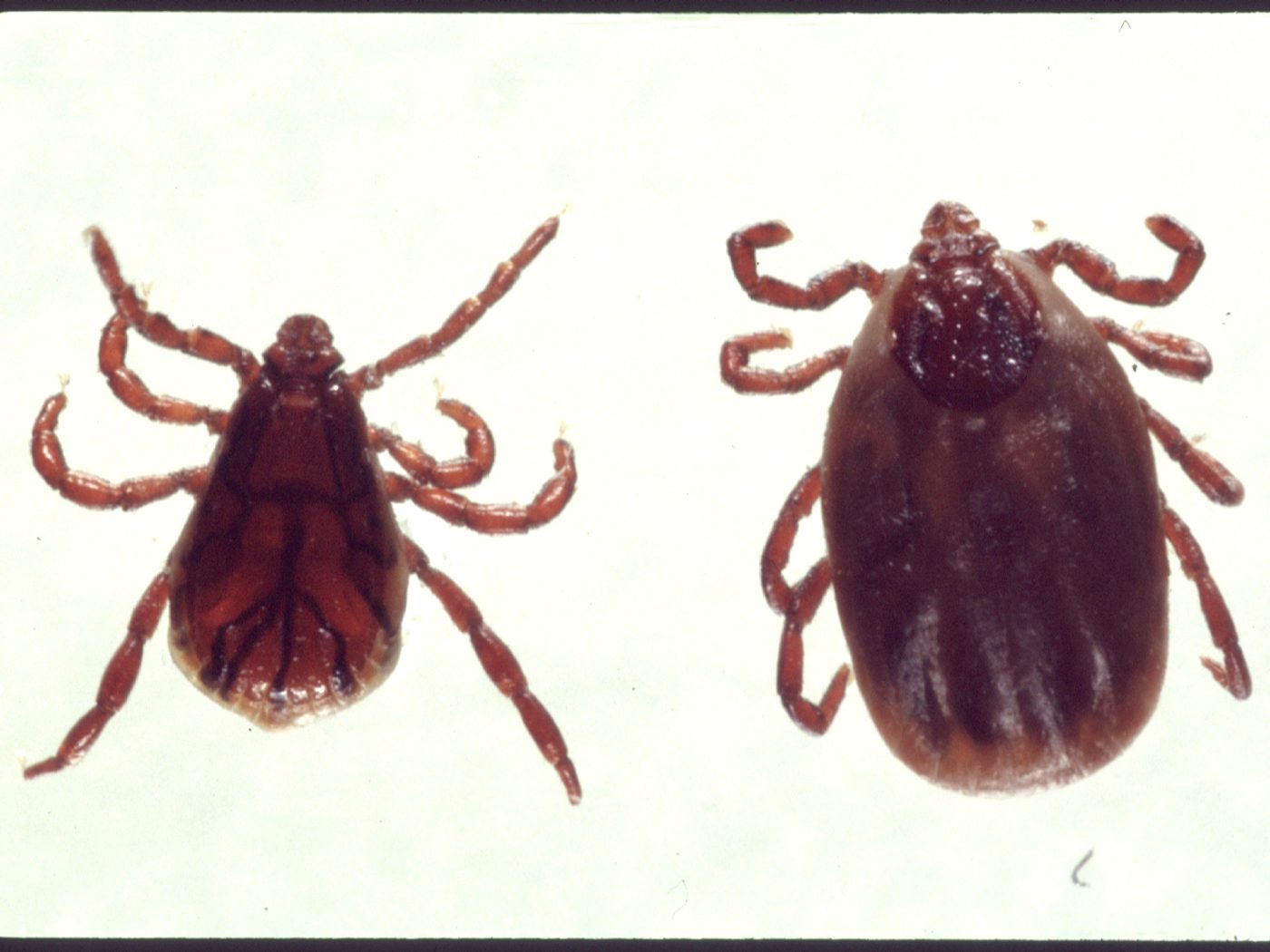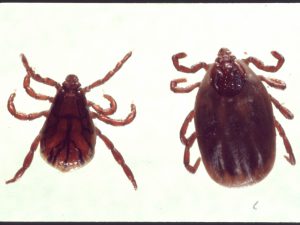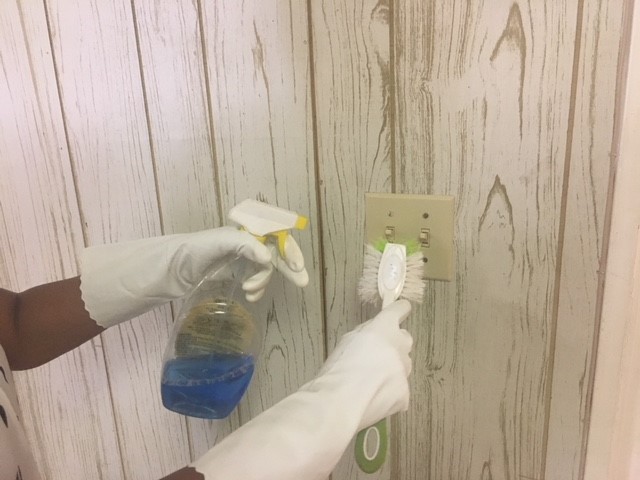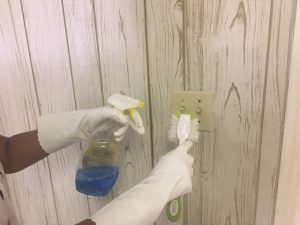
by Laurie Osgood | Jul 11, 2018

Check for ticks after being outside.
Photo source: http://photos.ifas.ufl.edu
Does the mere thought of ticks make you feel itchy all over? Ticks are not a fun thing to talk about, but we can’t ignore them. Ticks can pose a real threat to your outdoor summer fun. Here in the Florida Panhandle, you can find ticks all year-long. But ticks are the most active in warm weather, from April through September.
There are many varieties of ticks in the world, but only a few spread disease to people. Of the ticks that can be found in North Florida, the black-legged tick, also known as the deer tick, is the most dangerous because it is the primary vector of Lyme disease in humans. Learn more about the black-legged tick.
Symptoms of a Tick Bite
According to the UF/IFAS Extension’s Department of Entomology and Nematology guidebook, Pests In and Around the Southern Home, the most common symptoms associated with tick bites are rash, fever, chills, aches, and pains. If you have been bitten by a tick that carries Lyme disease, a bullseye-shaped rash may appear within 3-30 days. This circular rash usually appears before you experience fever or any other symptoms.
Although the rash tends to show up in most Lyme disease cases, it doesn’t always develop at the spot where you were bitten. If you’ve been bitten by a tick and are suffering from any of these symptoms, you should contact your doctor ASAP. They will evaluate the tick bite and decide the best treatment option for you. However, in most cases, when the tick is removed, these symptoms should subside within 24 hours. For more information, visit Ticks & Disease in Florida.
Checking Yourself and Your Family for Ticks
Ticks can be very small and hard to see. It is important to routinely check for ticks on all members of your family, including your pets. Examine your clothes, gear, and pets thoroughly after spending time outside. Experts advise us to wear light-colored clothing and closed-toe shoes when outside. Make sure to check your legs and ankles first, then move up your body. It’s important to remember that ticks are especially fond of warm areas on the body, so don’t forget to check all head and body hair, under your arms, the inside and outside of your ears and inside your belly button. Use a hand-held mirror for the best view of these spots on your body.
What is the Safest Way to Remove a Tick?
If you find a tick attached to your skin, don’t panic! It is important to remove the tick as soon as you spot it. The best way to remove the whole tick is with a pair of tweezers. Avoid twisting or yanking on the tick too quickly; this may cause some of the tick to remain attached to your skin. After removing the tick, thoroughly clean the site with soap, water, and rubbing alcohol.
Some believe the best way to remove a tick is by coating it with nail polish or petroleum jelly, causing the tick to detach itself from the skin. However, tweezers remain the quickest and safest way to remove the entire tick that is attached to the skin.
Preventing Ticks in Your Yard and On Your Pets

Check pets regularly for ticks.
Photo source: Pam Nobles
Our own backyard can be high-risk tick zones. We can help rid our yards of ticks by removing old trash and excess leaves, clearing tall grass, and mowing the lawn frequently. This is important especially around walkways, gardens, and the areas used for family activity.
Once you have protected your yard from ticks, don’t forget about your family pet. Adult ticks can attach themselves to your pet, who, unknowingly, bring these pests into your home. Once inside, they can easily spread disease to you or your family. You can defend your pets from these nuisances by talking to your veterinarian about the tick protective products they recommend for your pet.
To learn more about ticks and tick bites, visit the Centers for Disease Control’s (CDC) website for a comprehensive guide to all tickborne diseases in the United States.

by Laurie Osgood | Mar 20, 2018
 https://www.pexels.com/photo/blue-and-silver-stetoscope-40568/
https://www.pexels.com/photo/blue-and-silver-stetoscope-40568/
According to the American Cancer Society, colorectal cancer is the third most common cancer in the United States and the second leading cause of death from cancer. Colorectal cancer is cancer that occurs in the colon or rectum. Colorectal cancer affects all racial and ethnic groups and is most often found in people ages 50 and older. https://www.cancer.org/cancer/colon-rectal-cancer.html
Cancer Screening Saves Lives!
The best way to prevent colorectal cancer is to get screened regularly starting at age 50. Colorectal cancer doesn’t always cause symptoms, initially – which makes it much more important to get screened regularly. Make sure to talk to your doctor about when you should begin cancer screenings, how often, and which test is right for you.

What Can You Do To Reduce These Risks?
- Get regular screening starting at age 50
- Encourage your family members and friends over age 50 to get screened.
- Don’t smoke
- Be physically active
- Eat a diet rich in fruits, vegetables and fiber, while avoiding high fat foods
The U.S. Department of Health and Human Services, Centers for Disease Control and Prevention (CDC) provides fact sheets with more information about colorectal and other cancers. To learn more, visit https://www.cdc.gov/cancer/index.htm.
To learn more about colorectal cancer education and prevention efforts in your community, visit the Florida Department of Health at http://www.floridahealth.gov/diseases-and-conditions/cancer/colon-cancer/index.html or contact them at (850) 245-4330.
For more information about UF/IFAS Family and Consumer Sciences Program with the Gadsden County Extension, please contact Laurie Osgood at (850) 875-7255.

by Laurie Osgood | Mar 2, 2018

Clean light switches to reduce the spread of illnesses. Photo credit: NW Extension District
Seasonal influenza (flu) viruses are most common during the fall and winter, with peak activity occurring between December and February. According to the Centers for Disease Control and Prevention (CDC), the flu is a contagious respiratory illness caused by influenza viruses. It can cause mild to severe illness. Serious outcomes of flu infection can result in hospitalization or death. Some people, including senior adults, young children, and persons with certain health conditions, are at high risk for serious flu complications.
When someone in your family has had a cold or the flu, it is important to clean and sanitize your house properly to avoid any recurrences or further spreading. Follow these tips:
- Before you get started, try opening the windows for some fresh air, or raise your blinds or curtains to let in the natural light.
- Clean the areas first, then disinfect.
- Wash your hands often: before, during, and after cleaning.
IN THE BATHROOM
The bathroom will need a good cleaning and disinfection after an illness.
- Disinfect with a mixture of bleach and water. Use one scant teaspoon of chlorine bleach to one quart of water.
- Clean toilet lever, shower faucets, cabinet knobs, light switches, and doorknobs.
- Replace or clean toothbrushes.
|
IN THE KITCHEN
- Disinfect all things that people touch: refrigerator door handles; coffee pot; electric can opener; microwave oven; door, stove, and cabinet knobs; faucets; light switches. Do NOT use chlorine bleach with added fragrance, as it is not food-safe.
- Run all utensils through the dishwasher after each use.
- For more information on sanitizing the kitchen, see Cleaning and Sanitizing the Kitchen: Using Inexpensive Household Food-Safe Products.
|
IN THE FAMILY ROOM
- Clean remotes, phones, computer keypads, gaming systems, door knobs, and light switches.
- Sanitize all items with proper cleaning products.
|
IN THE BEDROOM
- Change pillow cases daily and wash soiled bed linens right away with proper laundry detergent.
- Wash everything in your washer on the hottest temperature the fabric allows, but be sure not to overload your washer.
- Disinfect all items on the night stand. Don’t forget light switches, doorknobs and drawer pulls, and remote controls, if used.
|
CLEANING KIDS’ TOYS
- Some stuffed animals can be cleaned in the washer with the other bedding.
- For hard-surfaced toys, make sure to clean with proper cleaning solutions for their surface and rinse well.
- Some small toys can be safely cleaned in a mesh laundry bag in the top rack of the dishwasher.
|
WHAT TOOLS ARE NEEDED?
- Rubber gloves
- A different sponge for each room you are cleaning or paper towels
- Proper cleaning products: Please be sure to follow all manufacturer’s instructions on all cleaning products.
According to the CDC, the flu virus can live on surfaces for 48 hours—potentially infecting anyone who comes in contact with the germs. Disinfecting the house is one of the best ways to prevent anyone else from contracting the illness.
For more information on sterilizing items in your home, visit the CDC Website, https://www.cdc.gov/oralhealth/infectioncontrol/questions/sterilization/cleaning.html
by Laurie Osgood | Feb 7, 2018
What Are the Differences of the Symptoms of a Cold, The Flu And Allergies?
Laurie Osgood, Family and Consumer Sciences Agent, UF/IFAS Extension, Gadsden County, FL
 You’re coming down with something…you have a stuffy nose, you’re coughing and you have a sore throat. Do you have a cold, the flu or seasonal allergies? Because the symptoms can be similar, it is hard to know what you are suffering from. Identifying the differences between symptoms can help you choose the best treatment options. However, you will need to visit your health care provider to know for sure.
You’re coming down with something…you have a stuffy nose, you’re coughing and you have a sore throat. Do you have a cold, the flu or seasonal allergies? Because the symptoms can be similar, it is hard to know what you are suffering from. Identifying the differences between symptoms can help you choose the best treatment options. However, you will need to visit your health care provider to know for sure.
The National Institutes of Health says that the flu and the common cold are caused by different viruses. Colds, the flu and allergies can affect your respiratory system, making it hard to breath. However each condition has key symptoms that set them apart. Flu symptoms can be more severe than cold symptoms and can lead to additional complications. Allergy symptoms can be similar, however they are caused by your body’s immune system reacting to a trigger, or allergen such as pollen, or pet dander.
The National Institutes of Health (NIH) has developed a chart to compare the symptoms of the cold, the flu and airborne allergies. To learn more about these symptoms, visit NIH @ https://newsinhealth.nih.gov/2014/10/cold-flu-or-allergy .
| SYMPTOMS |
COLD |
FLU |
AIRBORNE ALLERGY |
| Fever |
Rare |
Severe and usually high (100˚- 102˚ F) |
Never |
| Headache |
Uncommon |
Common |
Uncommon |
| General Aches, Pains |
Slight |
Usual, sometimes severe |
Never |
| Fatigue, Weakness |
Sometimes |
Usual, up to 3 weeks |
Sometimes |
| Extreme Exhaustion |
Never |
Usually at onset of illness |
Never |
| Itchy, Watery Eyes |
Unusual |
Unusual |
Common |
| Stuffy, Runny Nose |
Common |
Sometimes |
Common |
| Sneezing |
Usual |
Sometimes |
Usual |
| Sore Throat |
Common |
Sometimes |
Sometimes |
| Cough |
Mild to moderate |
Common, can be severe |
Sometimes |
| Chest Discomfort |
Mild to moderate |
Common |
Rare, except for those with allergic asthma |
| Duration |
Can last up to two weeks |
Usually last 1-2 weeks |
Can last as long as allergens are present |
| Treatment |
Get plenty of rest
Stay hydrated
Contact your doctor if symptoms persist |
Get plenty of rest
Stay hydrated
See your doctor for flu treatment options |
Avoid allergens, such as pollen, mold, pet dander, etc.
See your doctor to determine cause of allergic reactions |
| Complications |
Sinus infection middle ear infection, asthma |
Bronchitis, pneumonia; can be life-threatening |
Sinus infection, middle ear infection, asthma |
The best way to prevent getting sick this season is to wash your hands often, avoid close contact with people who are sick, and if you are sick, stay home. There can be severe complications associated with the flu, so get your flu shot each year and contact your doctor if you suspect that you or a loved one has the flu.
To learn more about colds, the flu or allergies, visit the National Institutes of Health at https://www.nih.gov/, or the Centers for Disease Control (CDC) at https://www.cdc.gov/flu/consumer/symptoms.htm
For more information about UF/IFAS Family and Consumer Sciences Program with the Gadsden County Extension, please contact Laurie Osgood at (850) 875-7255.
by Laurie Osgood | Oct 26, 2017

Apples are an ancient fruit, grown for thousands of years, and belong to the Rose family of plants. The Rose family also includes plums, raspberries, cherries, peaches, pears, and almonds.
According to Professor Peter C. Andersen, UF/IFAS Horticultural Sciences Department at the North Florida Research and Education Center in Quincy, the basics of apple growing haven´t changed much over the centuries. Although many homeowners in north Florida can grow apple trees, there is little potential for establishment of commercial apple orchards in Florida. Andersen says apples are difficult to grow in north Florida due to high rainfall, humidity, and insects during the apple-ripening season, which is late May through August. Apples need a chill period in order to set buds in the spring. Without a sufficient chill period, the apple tree will not cultivate. For more information on Florida apple varieties, check out Low-Chill Apple Cultivars for North Florida and North Central Florida.
Luckily, there are more than 8,000 varieties of apples grown worldwide, so you can still enjoy a selection of apples in north Florida, even if you aren’t able to grow them yourself.
Fun Apple Facts:
- Apples are very nutritious, especially when you eat the whole apple. The majority of the apple’s nutrients are in its skin.
- Apples are a good source of fiber and vitamin C and do not contain sodium, fat, or cholesterol.
- Apples ripen much faster at room temperature than if they are refrigerated.
- It takes about 36 apples to create one gallon of apple cider.
Apple Varieties:
Every type of apple has a distinct color, texture, and taste. There are more than 8,000 variations of apples grown worldwide. Here are some of the more well-known apples that are grown in the United States:
| Red Delicious |
This apple is grown in Iowa and is known for its deep red color and mild sweetness. The Red Delicious apple is finest when eaten whole or chopped up into salads. |
| Granny Smith |
This variety has a thick, green exterior with a sour taste. It is firm, crisp, and juicy inside and is best used for baking into pies and other baked goods. |
| Gala |
This variety has a waxy red and yellow skin with a golden interior. Its tart taste is ideal for baking or just eating. |
| McIntosh |
This apple grows abundantly in New England. McIntosh apples are crisp and juicy at their peak, but tend to soften quickly. This variety can be eaten off the tree or made into apple cider. |
| Golden Delicious |
This variety has a soft yellow skin and sweet flavor. This is considered an all-purpose apple that is ideal for snacking and cooking. |
| Empire: |
Empire apples are named for its home state of New York and is a mixture of a red delicious and a McIntosh apple. The Empire apple is crunchy and has a sweet taste, however, its texture changes quickly with extended storage, so it’s best eaten at its peak of freshness. |
Cooper, Emily. “Apples, a Bushel and a Peak of Flavor.” Food and Nutrition, 2017, pp. 28–29.
There are many other varieties of apples, and all are incredibly good for you. For the greatest benefits, eat the whole fruit — both skin and flesh.
To learn more about apples and their health benefits and healthy eating, please visit UF/IFAS Extension Solutions for Your Life or the USDA SNAP-Ed Connection.










